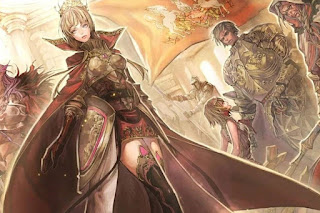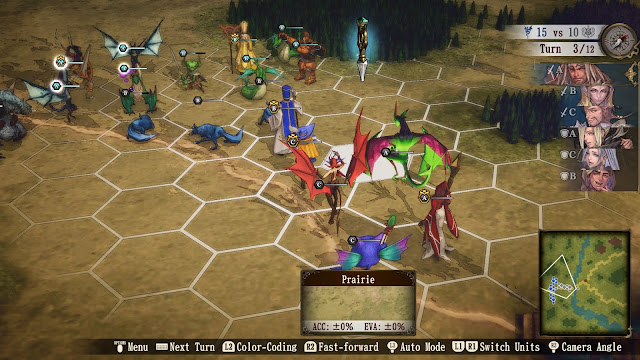I’ve already reviewed Brigandine: The Legend of Runersia on Nintendo Switch, which I did when it launched on the console earlier in the year. This PlayStation 4 (playable on PS5) release includes some quality of life improvements based on player feedback, but is functionally the same game, with the same qualities and the same features. As a result, I’m going to be quite brief with this review, but with a number of months to reflect on Brigadine now, I’ve got to say that this is one of the most under-appreciated games of the year and deserves a good deal more attention than it has received.
Brigandine is at heart a tactics RPG, though from screenshots you might be convinced otherwise. There’s a map, for example, dotted with castles, that suggests something much grander than battlefield tactics. However, the army and nation management stuff is very simple. There’s only one resource (mana) to manage, and only one thing to spend the mana on (monsters to use in combat). Then you form armies by giving your summoned monsters to “knights” (commanders), and then attack the enemy castles to expand your empire. That’s the extent of the game’s empire management strategy. As simple as it is though, it can be compelling. Different towns have different monsters, and therefore forming a balanced army actually relies on you making full use of the map. When your knights aren’t involved in invasions, you can send them on automated “quests” which will help you find more knights and level up your heroes. And just about every castle on the map is linked to at least two other castles, so while conquest is the objective in Brigandine, you need to constantly defend against counter-attacks. Indeed, if you put the difficulty up, it can be very hard to find openings and opportunities for expansion under any circumstances.
If the game were just an endless series of tactical battles, Brigandine would become dull quickly, but thankfully it is very story-orientated. There are six different factions to control, and each of them has a number of different knights and dynamics between them. Brigandine doesn’t do a whole lot to innovate with character archetypes and situations – different nations have stories of different social and personal drama, but they’re all archetypical – and yet I have now played through each nation’s story at least once because there’s something compellingly “high-class” about it. It’s full of references to poetry, national leaders write plays for hobbies or sneak out to be ballet performers. The art style itself looks like it was drawn from “high art” aesthetics and culture, and that plays through the narrative too. I think a lot of people will find the narrative dry and/or dull because of this, but it’s not often we get games that are as clearly inspired by Degas and the opera as they are Tolkien and games of Dungeons & Dragons at the pub.
The meat of Brigandine is the tactical action, however, and all by itself, it can almost be overwhelming for its nuanced depth and complexity. There are dozens of monsters that you can drag into battle, and they all have their own strengths, weaknesses, and abilities. Some are support troops, while others heal, and the front-line fighters are meant to swing wildly on each turn. Individually the strength of these creatures is nothing compared to the knights that command them, but they make useful meat-shields and allow for swarm tactics, and well-structured, synergistic groups of them can be deadly. Meanwhile, while those knights are powerful, and often have devastating attacks (particularly the magic users), they’re also vulnerable, clear targets, and if they get defeated in battle, all of their units disappear with them, putting their side at a big disadvantage, given that you can only take three knights into any one battle.
Pushing things along are strict turn limits – you’ve got 12 turns to either clear the other side away or capture their base and hold it. I can’t remember a single instance where I have ever won via base capture, since the enemy AI tends to beeline right towards your side and you fight to the death somewhere in the middle, but it is entirely possible to fail to clear the map in that time if you’re not strategic about the use of your characters and making sure that you’re targetting the knights. All of this is wrapped up in some very lovely presentation which, at first, looks simple, but as you fill your army up with a wide array of fantastic creatures, it’s a pure pulp fantasy delight on the eyes.
Brigandine is missing some pretty valuable features. A multiplayer mode would have been appreciated given that this is really just a glorified board game. Additionally, while I appreciate that the developer’s goal wasn’t to create a 4X, Civilization-like strategic experience, some rudimentary town-building, resource management, and diplomacy options would have been appreciated. I think back to the classic Heroes of Might & Magic titles, and they always managed to maintain the focus on the roleplaying and tactical combat while still letting you mess around with building up cities. Brigandine is a beautiful, compelling game, and the tactical action is rich, but it feels more shallow than it actually is because you spend so long looking at a map and castle screens where you’ve got about as much control as the most ancient strategy games like Defender of the Crown give you.
On the other hand, Matrix Games revived a niche and nearly forgotten 22-year-old game to deliver Brigandine: The Legend of Runersia. This may well be just a foundation to build on, assuming there’s an audience for it. I certainly hope there is, because this series could go very, very far yet.









